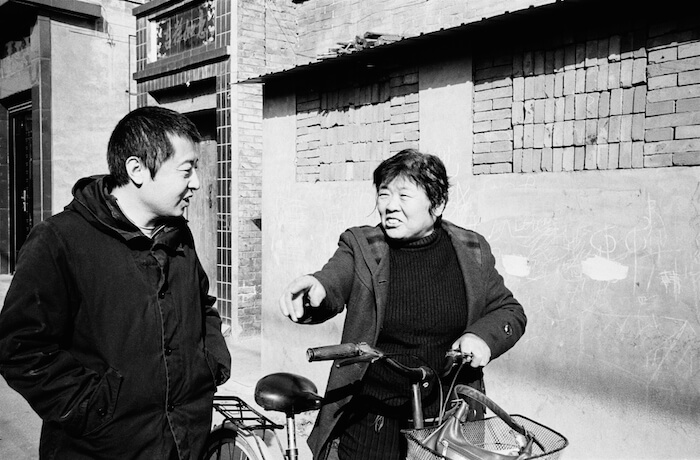Local Boys May Depart: Jia Zhangke, A Guy from Fenyang


Directed by Walter Salles
May 27-June 2 at Anthology Film Archives
Reviewing Mountains May Depart for this publication a few months ago, Nicolas Rapold began by noting that Jia Zhangke’s filmography is inextricably bound up in the sheer “scale of social and economic upheaval” in modern-day China. That Jia’s life story is also itself an at once profound and clipped-from-the-headlines-familiar story of a self-contained individual borne through almost unimaginable geographical, economic, political, familial and historical change in the space of a generation cannot come as much of a surprise. But the connections between life and art are filled in, naturally and vitally, in Jia Zhangke, A Guy from Fenyang.
Walter Salles, the director of The Motorcycle Diaries, is an unlikely match for the great mid-career filmmaker, but aside from the dubious rucksack-shouldering title and a hard-sell opening forefronting Jia’s most uncharacteristically lapidary reflections, the film stays mostly in a burrowing, essayistic vein. (It is also in color, despite the stoic protestations of all the promotional stills made available by the film’s distributor.) The opening, with Jia walking down the main street of his native Fenyang, in Shanxi province, noting the modernization of his old haunts—the karaoke places taken over by chains—and interacting with aging provincials who knew him way back when, is reminiscent of Olivier Assayas’s H.H.H.: A Portrait of Hou Hsiao-hsien, a high-water mark for the critical biography genre; so too is the cut from Salles’s footage to a clip of Xiao Wu, Jia’s first feature, shot on the same street in 1997.
It’s the first archival clip of many as the film moves, roughly chronologically, through Jia’s personal and cinematic lives, film stocks and aspect ratios changing along with the architecture: the blocky 16mm of pickpocket saga Xiao Wu seems almost as ancient as the stone-walled alley where Jia played as a child, and to which he returns here, to see the room where his family all slept in the same bed. He pats the walls approvingly—thick walls, a former prison—before visiting his mother, in the high-rise she now calls home, to report on what trees are growing in their old courtyard. Jia’s childhood and coming-of-age during and after the Cultural Revolution is paired with a welcome wealth of clips from his contemporaneous traveling-actor epic Platform (2000). (Including an extended reverie to George Lam’s unforgettable “Genghis Khan”—explaining the appeal of the pop music of his youth, Jia offers that culturally approved music during the 70s was all about “us,” “we,” the laboring collective, while Teresa Teng’s 80s love ballads at last sang of “I”.)
Jia pays a return visit to Beijing’s World Park, where, standing in the shadows of its still-standing Twin Towers replica, he reflects on his early-aughts introduction to the artificial frontage of “globalization” as a newly mobile emerging world filmmaker—as seen in the hypnotically HD, techno-scored widescreen of The World (2004), his first film set outside of Shanxi, and first to circulate in his home country via legitimate theatrical screenings, rather than the bootleg DVDs he recalls ruefully. Zhao Tao, World star and Jia’s wife (though not labeled as such here, they married in January of 2012), intriguingly states that the film was inspired by her own remembrances of working at Shenzen’s Window on the World Park (where some of The World was actually filmed).
Jia discusses the monumental themes of his semifictional documentary 24 City (2008), about the decline of manual labor, real estate development, memory and displacement, in front of a packed lecture hall at a Beijing arts university, and the flicker of smartphone screens; hip-joined cinematographer Yu Lik-wai, whose long takes have been a constant in Jia’s style as it developed from neorealist asceticism to arthouse trance and beyond, discusses the supple reflexiveness that informed Still Life (2006), a stoic portrait of demolition and migration around the massive Three Gorges Dam project. Still Life, shot on DV with a loose script, was made on location through a process of measured spontaneity Jia moved away from with his subsequent fiction film, the volatilely topical genre exercise A Touch of Sin (2013).
A Guy from Fenyang becomes more DVD-supplementary as it goes: films are discussed more as intentional commentaries on Chinese society than as multivalent reflections of it, and clips become more blandly illustrative. An 11th-hour attempt to introduce a dramatic arc, about Jia facing down government censors over A Touch of Sin’s content, is incomplete (and out-of-date—this film’s meander through postproduction and the international festival and specialty circuit makes it an odd fit for reportage). But the film remains interesting and valuable for its sense of Jia at low-key ease in almost incomprehensibly different worlds, among aunties, accountants and artists, seemingly able to comfortably reconcile within himself the here and now with the then and there. It gives weight to Jia’s musing, towards the end of A Guy from Fenyang, over what the characters of his first films would make of the 21st century. That’s a question at the forefront of his multigenerational Mountains May Depart (and one that may occur to you independently if you’ve been following Jia’s career from NYC since he broke out with the force of revelation a decade and a half ago). It’s also earned in this documentary, where sudden cuts between the man and the films create loops of personal and cultural memory very reminiscent of a Jia Zhangke film.
You might also like 




















